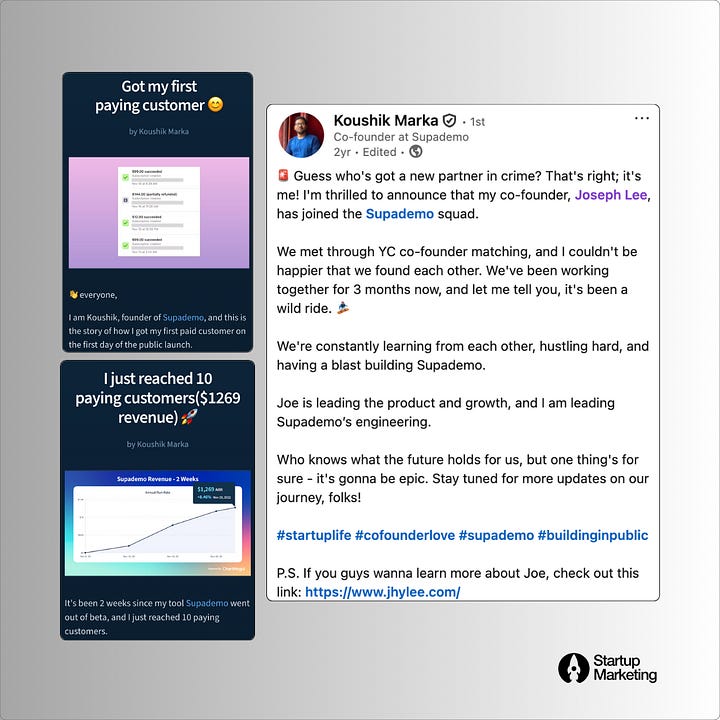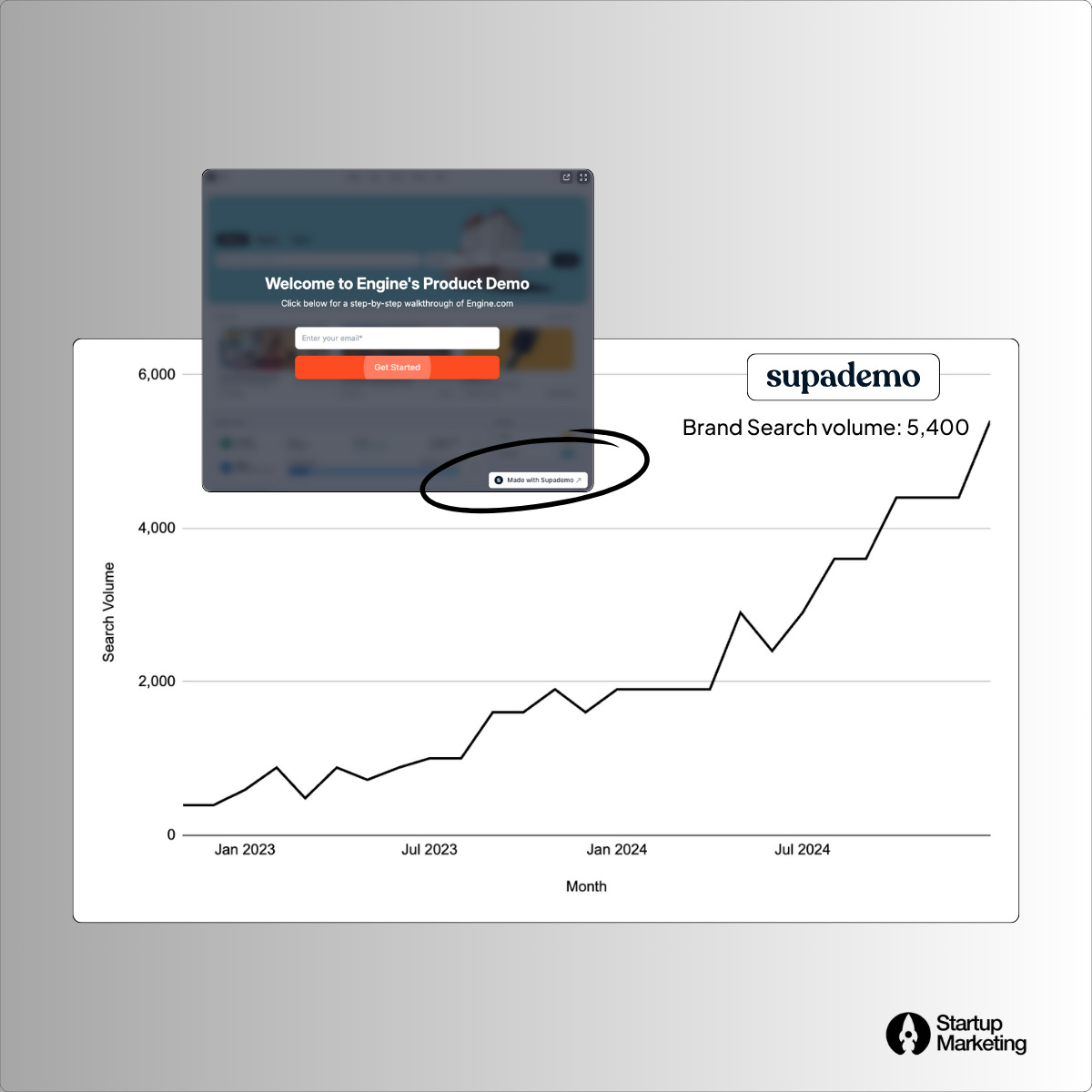Supademo’s $0 to $1 Million ARR Marketing Strategy
From launch to $1M ARR using free demos, product-led SEO, and loginless onboarding.
👋 Hey, it’s Elan. Welcome to my ‘Startup Marketing’ newsletter, where every other week I pick one successful SaaS startup and break down how it grew from $0 to $1 million in ARR. I specifically focus on their marketing strategies - where they started, what worked, and how they executed it.
I was debating whether to cover Zapier or Lovable this week — until I stumbled upon an interview with one of Supademo’s founders. Their growth story intrigued me enough to learn more about their journey. Supademo recently crossed $1 million in ARR, and like the other products I’ve covered, their early-stage marketing had plenty of interesting elements.
Let’s dive in.
About Supademo
Supademo is a no-code platform that lets you create interactive product demos in minutes. Launched in November 2022, they’ve grown to:
1,500+ paying customers
60,000+ users
About the Team
Koushik Marka: A serial entrepreneur who previously founded Studiotale, a video marketing agency specializing in demo and explainer videos.
Joseph Lee: Also a serial entrepreneur, previously founded Freshline (eCommerce for food distributors) and scaled it to $3M in revenue.
The Supademo team currently has 9 members.
The Premise
New tool entering a space with established competitors
Lean team with founder-led marketing
Most incumbents were enterprise-focused
Deep domain understanding, especially around product demos
The Marketing Strategy
Supademo’s initial focus was on “busy founders.” The idea: offer a fast, efficient way to build product demos for sales, onboarding, and marketing — without needing a designer or dev. This strategy is reflected in their messaging, content, and channels.
Over time, they shifted focus toward larger companies, targeting product marketing, sales, and customer success teams.
How did they go about it?
Launch in founder communities
Free demo giveaways
Product-Led SEO (inspired by Zapier)
Product update email outreach
Ungated product access
Founder-led content
In-built shareability
The Launch
They initially launched on Hacker News, Indie Hackers, and Reddit — communities filled with early-stage founders. The response was strong and helped generate their first wave of traction. Within the first few weeks, they saw:
300 signups
200+ user demos
4 paying customers
Free Interactive Demos
After launch, they offered free interactive demos to founders on Reddit and Indie Hackers. Founders would share their product, and Supademo would create an interactive demo for free. It was a simple but powerful way to showcase the product’s value, and it drove tons of signups.
Joseph and Koushik repeated this playbook across different platforms and communities. Each time, it sparked a lot of engagement. In total, they created interactive demos for 100+ products.
Outreach via Product Update Emails
They subscribed to product updates from other SaaS tools, then created Supademo demos for new features and sent them back to the team. Since product marketers typically handle those updates, this approach got them straight to decision-makers in their ICP — a clever outbound tactic.
ProductHunt Launch
Compared to other products we’ve covered, Supademo saw strong engagement through their Product Hunt launches. They launched on Product Hunt about a month after their public debut. Their first launch received 250+ upvotes, and subsequent launches garnered 700+ upvotes each. Their most recent launch even became the #1 Product of the Day.
Product-Led SEO
Supademo leaned into SEO early, building a strategy inspired by Zapier’s playbook —leveraging other brands’ visibility and reach.
Targeted software task-related "how-to" queries like “How to export a file as PDF in Figma”. Supademo has covered 450+ such use cases, with each page featuring an interactive demo that walks users through the task.
They also targeted "[Brand] + demo" searches like “Zendesk demo” and “Mixpanel demo.” So far, they’ve created demo pages for 45+ brands and 20 of those pages are ranking in top 10. Supademo focused on products with ICP overlap, crafting tailored interactive demos for each.
Both of these approaches helped Supademo reach their ideal customers — even when those customers weren’t actively searching for Supademo itself.
They built this foundation way before demo-led SEO was thing. Today, this strategy accounts for nearly 50% of their organic traffic.
Loginless Demos
Supademo noticed that sign-up friction was preventing users from reaching the “aha” moment. So they made the product accessible without requiring a signup — no registration, no emails, no confirmation steps. Joseph called it Loginless Demos. Users could try the product first and only sign up after experiencing its value.
This shift improved both the quality of signups and overall product adoption.
Free Tools (Bonus SEO Win)
I should have included this as part of SEO but, it deserves a special mention. As a byproduct of their ungated model, they spun off modular tools from their core product and offered them as standalone free tools, optimized for SEO.
These free tools now drive 20% of their organic traffic. In an interview, Joseph mentioned that nearly 11–12% of visitors to the free tools page end up converting into signups.
Founder-Led Marketing
The founders took a 'build in public' approach and stayed highly active in founder communities across platforms.
Koushik engaged with the founder community through Indie Hackers, X, and LinkedIn, consistently sharing updates on Supademo’s user growth, revenue milestones, and progress.


Joseph focused on thought leadership, regularly sharing insights on growth and product updates across LinkedIn, X, Indie Hackers, and Medium. He often wrote about startups, product building, team hiring, fundraising, and more.
Here are some of his top posts:
One of his recent LinkedIn post about product onboarding got 3K+ engagements.
Shareability
Supademo’s product is inherently shareable. Free users’ interactive demos include a watermark, so when shared or embedded on other sites, it gives Supademo visibility. This likely played a big role in increasing their brand search volume from 0 to 5,000+ in two years — without big-brand campaigns.
Supademo’s Growth Loop
Final Thoughts
Supademo’s growth didn’t come from flashy tactics or one big viral moment. It was the result of showing up every day and doing the small, non-scalable things that compound over time.
They stacked a series of low-friction, high-leverage experiments — whether it was ungating the product, replying to Reddit posts, or creating demos for product update emails. Each move helped reduce friction and get the right people to experience the product.
Their approach reinforces what we’ve seen in other growth stories: early growth is often just about doing the unscalable things.













